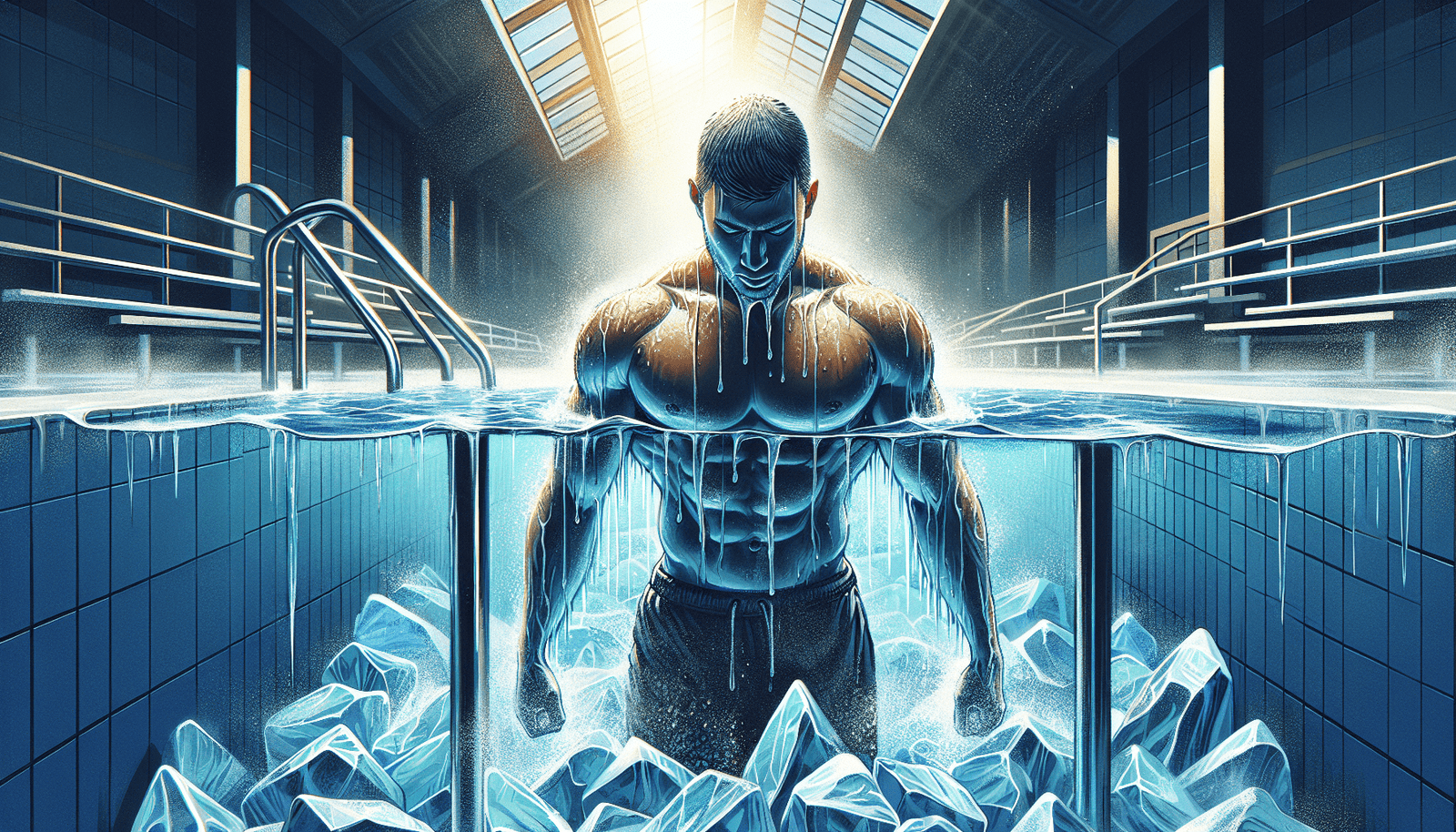Are you an athlete looking for ways to enhance your recovery after intense training sessions? Look no further than cold plunges. This article explores the benefits of cold plunges for athletes, shedding light on how this practice can help reduce muscle soreness, improve circulation, and promote overall recovery. So, get ready to discover why incorporating cold plunges into your post-workout routine may be exactly what your body needs.
Benefits of Cold Plunges for Athletes
Reduced Inflammation
One of the key benefits of cold plunges for athletes is reduced inflammation. After intense training or competition, athletes often experience muscle soreness and inflammation, which can hinder their recovery. Cold plunges, which involve immersing the body in cold water for a specific period, have been shown to reduce inflammation by constricting blood vessels and decreasing blood flow to the affected areas. This reduction in inflammation can accelerate the healing process and help athletes recover faster.
Improved Muscle Recovery
Cold plunges are also known to improve muscle recovery. The exposure to cold water promotes vasoconstriction, which helps remove metabolic waste products from the muscles. This clears out toxins and metabolites that build up during strenuous exercise, allowing the muscles to repair and recover more quickly. Additionally, the cold temperature helps to reduce muscle spasms and tightness, aiding in overall muscle recovery.
Increased Mental Alertness
Another benefit of cold plunges for athletes is increased mental alertness. Plunging into cold water triggers the body’s “fight-or-flight” response and activates the sympathetic nervous system. This response releases adrenaline and other hormones, providing a surge of energy and improving focus and mental clarity. Athletes who incorporate cold plunges into their training routine often experience improved concentration and enhanced cognitive function, which can be beneficial for optimum performance.
Ideal Temperature for Cold Plunges
Optimal Temperature Range
The ideal temperature for cold plunges typically ranges between 50 to 59 degrees Fahrenheit (10 to 15 degrees Celsius). This temperature range is cold enough to trigger the desired physiological responses without posing a significant risk to the athlete’s health. It is important to note that individual preferences and tolerances may vary, and athletes should adjust the temperature to a comfortable level that still provides the intended benefits.
Duration of the Plunge
The duration of the cold plunge depends on the individual’s tolerance and experience. Generally, athletes start with shorter durations, such as 2 to 5 minutes, and gradually increase the time as they become more accustomed to the cold. It is crucial to monitor the body’s response and adjust the duration accordingly. It is not advisable to stay in the cold water for an excessively long time, as it may lead to hypothermia or other adverse effects.
Precautions and Safety Measures
Consulting a Healthcare Professional
Before incorporating cold plunges into their training routine, athletes should consult a healthcare professional, such as a sports medicine doctor or physical therapist. These professionals can provide personalized advice based on the athlete’s medical history, current condition, and training goals. They can also assess any potential risks or contraindications and guide athletes on how to safely implement cold plunges for recovery.
Avoiding Cold Plunges with Certain Medical Conditions
While cold plunges offer numerous benefits, athletes with certain medical conditions should avoid them or seek guidance from a healthcare professional. Individuals with cardiovascular problems, respiratory disorders, Raynaud’s disease, or a compromised immune system should exercise caution and consult their physician before attempting cold plunges. It is important to prioritize safety and consider individual circumstances to prevent any adverse reactions or complications.
Gradual Adaptation to Cold Temperatures
Athletes who are new to cold plunges should gradually adapt their bodies to the cold temperatures. Starting with shorter durations and cooler water temperatures allows the body to acclimate to the stress of cold immersion. As the body becomes more accustomed to the cold, athletes can progressively increase the duration and lower the temperature. This gradual adaptation approach helps minimize the risk of shock to the system and optimizes the benefits of cold plunges for recovery.
Best Practices for Cold Plunges
Gradual Temperature Decrease
To optimize the benefits of cold plunges, it is recommended to gradually decrease the water temperature. Starting with lukewarm water and gradually adding ice or cold water allows the body to adjust more comfortably. Jumping into extremely cold water abruptly may shock the system and cause an adverse reaction. By gradually decreasing the temperature, athletes can acclimate their bodies and obtain the desired benefits of the cold plunge.
Proper Immersion Technique
Proper immersion technique is crucial to ensure maximum benefits from cold plunges. It is recommended to submerge the entire body, up to the neck, to fully engage the physiological responses triggered by the cold water. Deep breaths and controlled breathing can help manage the initial shock of the cold temperature. Athletes should focus on relaxing the body and embracing the cold, rather than resisting it. Maintaining good posture and moving gently in the water can also enhance the effectiveness of the cold plunge.
Post-Plunge Recovery Routine
After completing a cold plunge, athletes should follow a post-plunge recovery routine to further enhance the benefits. This routine may include activities such as gentle stretching, foam rolling, or using a massage gun to promote muscle relaxation and recovery. Staying warm and dry after the cold immersion is important to prevent a rapid drop in body temperature. It is also advisable to hydrate adequately and refuel with a nutritious snack to support the body’s recovery process.
Cold Plunges vs. Ice Baths
Difference in Temperature
Cold plunges and ice baths differ in temperature, with cold plunges typically being colder than ice baths. Cold plunges involve immersing the body in water ranging from 50 to 59 degrees Fahrenheit (10 to 15 degrees Celsius), while ice baths generally use water temperatures between 59 and 68 degrees Fahrenheit (15 to 20 degrees Celsius). The lower temperature of cold plunges activates stronger physiological responses and may provide more potent benefits due to the greater temperature difference.
Benefits and Drawbacks
Both cold plunges and ice baths offer benefits for athletes, but they also have their drawbacks. Cold plunges, with their lower temperatures, may be more effective in reducing inflammation and accelerating recovery. However, the colder temperatures can be challenging to tolerate for some individuals, especially those new to cold immersion. Ice baths, on the other hand, may be more tolerable for beginners and can still provide benefits in terms of reduced muscle soreness and improved circulation. Athletes should consider their preferences, goals, and personal tolerance when choosing between cold plunges and ice baths.
When to Incorporate Cold Plunges into Training
Post-Workout Recovery
Cold plunges are particularly beneficial when incorporated into an athlete’s post-workout recovery routine. After intense training or competition, the body undergoes stress and experiences muscle damage. Cold plunges can help mitigate this stress and promote a quicker recovery by reducing inflammation, flushing out metabolic waste products, and improving circulation. By incorporating cold plunges into their post-workout routine, athletes can enhance their recovery and prepare their bodies for subsequent training sessions.
Injury Rehabilitation
Cold plunges can also play a valuable role in injury rehabilitation. For athletes recovering from injuries or surgeries, cold immersion therapy can aid in the healing process by minimizing inflammation, reducing pain, and promoting tissue repair. Cold plunges can be particularly effective for injuries involving acute inflammation, such as sprains or strains. However, it is essential to consult with a healthcare professional or physical therapist to determine the appropriate timing and duration of cold plunges during the rehabilitation process.
Cold Plunges as a Performance Enhancer
Benefits for Endurance Athletes
Cold plunges offer unique benefits for endurance athletes. Engaging in prolonged, intense endurance activities can lead to significant muscle damage and inflammation. Cold plunges can help reduce this inflammation, improve muscle recovery, and enhance overall endurance performance. By incorporating cold plunges into their training routine, endurance athletes may experience a faster recovery time, less muscle soreness, and improved muscular endurance, allowing them to train more effectively and achieve better results.
Mental Conditioning and Discipline
Beyond the physical benefits, cold plunges can also contribute to mental conditioning and discipline for athletes. Enduring the discomfort of cold water immersion requires mental resilience and can strengthen an athlete’s ability to push through discomfort during training or competition. The cold plunge becomes a metaphor for the mental challenges athletes face in their sport, teaching them to embrace discomfort, stay focused, and persevere. This mental conditioning gained from cold plunges can positively impact an athlete’s performance and resilience in various aspects of their training and competition.
Popular Cold Plunge Techniques
Cryotherapy Chambers
Cryotherapy chambers are a popular and convenient way to experience the benefits of cold plunges. These chambers use liquid nitrogen or refrigerated cold air to lower the air temperature significantly, creating a cold environment that the athlete can enter. Cryotherapy chambers offer controlled temperatures and customizable durations, allowing athletes to safely incorporate cold immersion into their recovery routine. These chambers often provide an all-encompassing cold experience and are used by many professional athletes and sports teams.
Natural Water Sources
Natural water sources, such as lakes, rivers, or the ocean, can also serve as cold plunge locations for athletes. These natural water sources often offer the added benefit of being in a serene and picturesque environment, allowing athletes to combine the benefits of cold immersion with the therapeutic effect of nature. However, it is important to assess the temperature and safety of the water before immersing oneself and to consider the weather conditions and any potential risks associated with natural bodies of water.
Ice Baths
Ice baths, as the name suggests, involve filling a bathtub or large container with cold water and adding ice to lower the temperature. Ice baths provide a convenient and cost-effective option for athletes looking to experience the benefits of cold immersion. While the temperature may not be as low as in a cryotherapy chamber, ice baths can still offer therapeutic benefits, reducing inflammation, and aiding in muscle recovery. Athletes can easily create their own ice baths at home or in their training facilities with the proper preparation and precautions.

Notable Athletes Who Utilize Cold Plunges
Case Studies and Testimonials
Many notable athletes across different sports have incorporated cold plunges into their training and recovery routines. Case studies and testimonials from these athletes provide compelling evidence for the benefits of cold plunges. For example, professional football player Tom Brady has spoken about his regular use of cold therapy as a crucial part of his recovery and preparation for high-performance activities. Other athletes, such as LeBron James and Michael Phelps, have also shared their positive experiences with cold immersion therapy. These case studies and testimonials highlight the potential advantages and encourage athletes to consider incorporating cold plunges into their own routines.
Conclusion
Cold plunges offer a multitude of benefits for athletes, including reduced inflammation, improved muscle recovery, and increased mental alertness. By immersing the body in cold water, athletes can experience physiological responses that aid in their overall recovery and performance. However, it is important to consider the ideal temperature, duration, and safety measures when incorporating cold plunges into training routines. Consulting with healthcare professionals, gradually adapting to the cold temperatures, and following best practices can ensure an effective and safe cold plunge experience. Whether athletes choose cryotherapy chambers, natural water sources, or ice baths, they can reap the benefits of cold immersion therapy and enhance their training, recovery, and performance.





